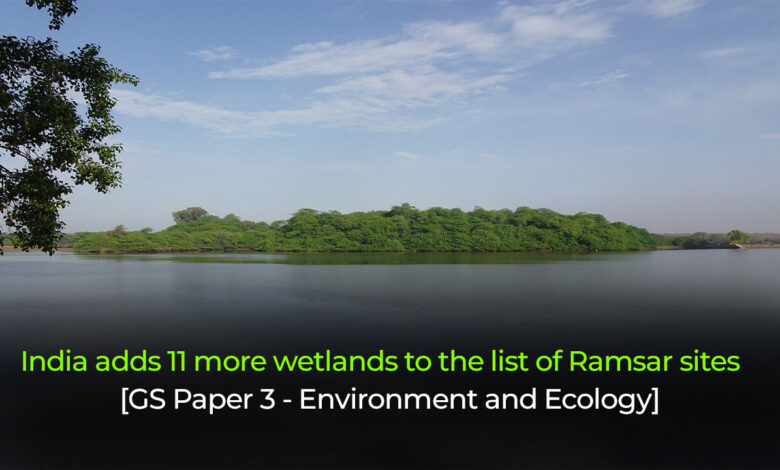Daily Current Affairs for UPSC
India adds 11 more wetlands to the list of Ramsar sites
[GS Paper 3 - Environment and Ecology]

Context – India has added 11 more wetlands to the list of Ramsar sites, marshes that are of international importance, bringing the country’s total tally to 75.
Of the 11 new sites, four are in Tamil Nadu, three in Odisha, two in Jammu and Kashmir, and one each in Madhya Pradesh and Maharashtra.
Key Highlights
- “India adds 11 more wetlands to the list of Ramsar sites to make a total 75 Ramsar sites covering an area of 1,326,677 ha in the country in the 75th year of Independence. During this year itself (2022), a total of 28 sites have been declared as Ramsar sites. Based on the date of designation mentioned on the Ramsar certificate, the number is 19 for this year (2022) and 14 for the previous year (2021),” the statement said.
- The latest additions are:
- Tampara Lake (300 hectares),
- Hirakud Reservoir (65,400 hectares) and Ansupa Lake (231 hectares) in Odisha;
- Yashwant Sagar (822.90 hectares) in Madhya Pradesh;
- Chitrangudi Bird Sanctuary (260.47 hectares), Suchindram Theroor Wetland Complex (94.23 hectares), Vaduvur Bird Sanctuary (112.64 hectares) and Kanjirankulam Bird Sanctuary (96.89 hectares) in Tamil Nadu;
- Thane Creek (6,521.08 hectares) in Maharashtra; and
- Hygam Wetland Conservation Reserve (801.82 hectares) and Shallbugh Wetland Conservation Reserve (1,675 hectares) in Jammu and Kashmir.
- India in 1982 became a signatory to the 1971 Ramsar Convention, whose mission is “the conservation and wise use of all wetlands through local and national actions and international cooperation, as a contribution towards achieving sustainable development throughout the world”.
- From 1982 to 2013, a total of 26 sites were added to the list of Ramsar sites in the country. From 2014 to 2022, another 49 additions were made.
About RAMSAR Sites
- A Ramsar site is a wetland of international importance under the Ramsar Convention, which is also known as the ‘Convention on Wetlands’ — an intergovernmental environmental treaty established by UNESCO in 1971, and named after the city of Ramsar in Iran, where the convention was signed that year.
- Ramsar recognition is the identification of wetlands around the world, which are of international importance, especially if they provide habitat to waterfowl (about 180 species of birds).
- There is international interest and cooperation in the conservation of such wetlands and a judicious use of their resources.





.png)



